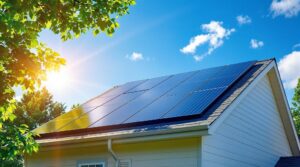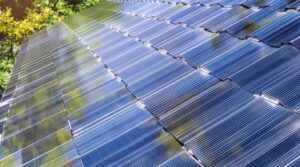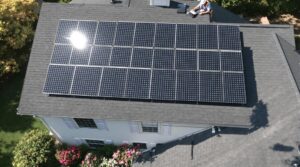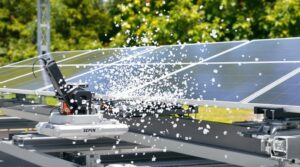Thinking about turning your roof into a money-saving powerhouse? Let's talk solar panels! These sun-catching champions can slash your energy bills by up to $110,000 over 25 years – that's like finding a treasure chest on your rooftop! Plus, they'll boost your home's value by 4.1%, making your property even more attractive to future buyers.
Sure, the upfront investment might make you catch your breath ($15,000-$25,000), but Uncle Sam's got your back with a generous 30% tax credit until 2032. Think of it as the government's high-five for going green!
Before you jump on the solar bandwagon, though, let's get real about what your roof needs. Just like a sunbather needs the perfect spot, your solar panels crave optimal positioning and a sturdy support system. Not every roof is ready for its solar debut, but don't let that dim your enthusiasm!
What about the long game? These hardy panels keep pumping out 80% of their original power even after four decades – talk about aging gracefully! With minimal TLC needed, they're like the low-maintenance friend who always shows up when you need them.
Ready to join the solar revolution? Your roof might be sitting on a goldmine of sustainable savings – you just need to decide if it's time to tap into that potential!
Key Takeaways
Thinking About Solar? Here's What Your Wallet (And Planet) Need to Know
Ready to turn your roof into a money-saving powerhouse? While the upfront investment of $15,000-$25,000 might make you gulp, Uncle Sam's got your back with a sweet 30% tax credit. Plus, imagine pocketing up to $110,000 in energy savings over 25 years – that's like finding a small fortune in your attic!
Your Home's Secret Superpower
Want to boost your property's curb appeal? Solar panels are like a high-tech crown for your house, typically boosting its value by 4.1%. Even better, solar-equipped homes are snapped up 20% faster in the market. Talk about a bright investment!
The Nitty-Gritty of Going Green
Let's keep it real – your solar system needs some TLC. Think of it as maintaining a high-performance car: annual check-ups and occasional inverter replacements ($1,000-$2,500) keep everything running smoothly. But here's the kicker: these panels are marathon runners, keeping 80% of their power output for up to four decades!
Your Personal Climate Action Hero
By turning your roof into a clean energy generator, you're essentially planting 150 trees every year – that's what eliminating 3 tons of carbon emissions looks like. How's that for being an eco-warrior?
The Fine Print
Before you jump on the solar bandwagon, let's talk roof specs. Your roof's orientation, angle, and condition all play crucial roles in your solar success story. Think of it as finding the perfect spot for your garden – location matters!
Financial Benefits and Investment Considerations
Installing rooftop solar panels represents a significant upfront investment that typically yields substantial long-term financial returns. A standard 5kW system requires an initial cost between $15,000 and $25,000, but generates savings of $25,000 to $110,000 over its 25-year lifespan through reduced electricity bills.
The financial benefits extend beyond utility savings. Property values increase by approximately 4.1%, with every dollar saved on energy costs translating to a $20 boost in home value. Premium solar panels experience minimal efficiency loss of just 0.3% per year.
Solar installation boosts property values 4.1%, transforming each dollar of energy savings into $20 of added home worth.
Federal tax credit programs offer 30% reductions on initial costs through 2032, while state-specific tax breaks and Solar Renewable Energy Credits provide additional incentives. The average payback period is 8 years nationally, though this varies by region based on local electricity rates.
Homeowners can access zero-down solar loans with terms ranging from 5 to 30 years, making the change more accessible despite varying interest rates based on creditworthiness.
Most systems feature performance warranties that guarantee 80% power output for up to 40 years, protecting the long-term investment.
System Requirements and Installation Factors
The installation of rooftop solar panels requires specific structural prerequisites, including an unobstructed south-facing roof with a slope between 15-40 degrees for maximum energy generation.
Professional installation by NABCEP-certified technicians guarantees compliance with local building codes and proper integration of mounting systems compatible with existing roofing materials.
Regular cleaning and maintenance help solar panels maintain 90% power capacity for up to two decades of operation.
The complete installation process encompasses multiple components, including proper panel positioning, secure mounting hardware, inverter setup, and electrical connections that must pass final inspection for safety certification.
Each panel installation requires approximately 2.1 square meters of available roof space to ensure optimal positioning and ventilation.
Roof Configuration Requirements
Successful solar panel installation depends on several critical roof configuration requirements that determine system performance and feasibility. Peak energy production requires south-facing roof orientation with an angle between 15-40 degrees. The structural integrity of the roof must support an additional 2-4 pounds per square foot of solar panel weight.
The mounting system's compatibility with roofing materials is essential, as certain materials like slate or wood shake may present installation challenges or prove unsuitable. Installing impact-resistant panels can help protect against severe weather damage while maintaining optimal performance.
Unobstructed exposure to direct sunlight dramatically impacts system efficiency, making proper roof orientation essential. Shade from trees or surrounding buildings must be evaluated during site assessment, as these obstacles can substantially reduce the solar array's performance. These configuration factors collectively determine whether a roof is appropriate for solar panel installation. Professional installers must ensure joist spacing requirements of 24 inches and grade 2 or better wood quality for proper mounting.
Professional Installation Process
Professional solar panel installation demands adherence to rigorous technical standards and safety protocols overseen by NABCEP-certified technicians. The process requires careful evaluation of roofing materials to guarantee structural compatibility with the mounting system, accounting for an additional load of 2-4 pounds per square foot. Ground-mounted systems may require special insurance coverage under "other structures" provisions.
Certified solar installers must position panels at ideal angles between 15-40 degrees, typically favoring south-facing orientations for maximum efficiency. The power system integration involves precise cable connections linking panels to inverters and optional battery storage components.
Installation costs reflect the complexity of proper weatherproofing, electrical wiring, and structural modifications required for a typical 5kW residential system. Each solar panel installation must meet local building codes and pass final electrical inspections to verify safety and operational compliance with international standards. Regular maintenance with proper cleaning procedures can extend the life of installed panels by up to 5 years while maintaining optimal performance levels.
Environmental Impact and Sustainability
Modern rooftop solar panels represent a substantial advancement in sustainable energy production, demonstrating remarkable environmental benefits throughout their operational lifetime. Solar energy systems become carbon neutral within three years of operation and continue producing clean energy for up to 35 years, generating 20 times less carbon footprint compared to coal-based power generation.
A typical residential installation reduces household carbon emissions by approximately 3 tons annually, considerably contributing to climate change mitigation efforts. Regular maintenance records are essential for maintaining valid insurance coverage and environmental performance.
Installing home solar panels eliminates 3 tons of carbon emissions yearly, making a significant impact on fighting climate change.
While the environmental impact of solar panels includes some concerns regarding toxic materials like lead and cadmium, manufacturers are developing more sustainable alternatives. The EPA's classification of old panels as hazardous waste underscores the importance of proper disposal protocols.
Despite these considerations, solar panels remain a vital renewable energy solution, producing zero carbon emissions during operation and offering substantial long-term sustainability benefits when properly managed through their lifecycle. Quality solar installations can maintain 80% power output for up to four decades with proper maintenance and cleaning.
Location and Climate Compatibility
The effectiveness of rooftop solar installations depends heavily on geographical location, roof orientation, and local climate conditions. South-facing roofs with inclinations between 15-40 degrees provide ideal power generation in most geographic regions, while east or west-facing installations typically produce 15-20% less energy.
Local weather patterns play a vital role in solar system performance.
Regions experiencing abundant sunlight, such as Hawaii and Sarasota, Florida, which averages 251 sunny days compared to the national average of 205, offer superior conditions for energy production. Hawaii's exceptional sun exposure, approximately double the national average, combined with electricity costs twice the national norm, creates favorable conditions for solar investment.
When evaluating location compatibility, three key factors determine system viability: roof orientation, local climate patterns, and regional electricity costs. These elements collectively influence the overall efficiency and economic feasibility of rooftop solar installations.
Performance and Energy Generation
Residential solar panel systems demonstrate consistent power generation capabilities throughout their 25-35 year operational lifespan, converting between 15-20% of captured sunlight into usable electricity. High-efficiency panels can achieve conversion rates up to 22% under ideal conditions, maximizing energy generation potential.
Optimal performance is achieved through south-facing installations positioned at 15-40 degree angles, yielding up to 30% more power compared to other orientations. While east and west-facing installations remain viable, they produce 15-20% less energy than south-facing configurations.
During peak sunlight hours, systems often generate excess electricity that can be fed back into the grid through net metering arrangements.
Though solar panels continue functioning during cloudy conditions at reduced efficiency and cannot generate power at night, their minimal maintenance requirements and ability to operate in various weather conditions make them a reliable source of renewable electricity.
Battery backup or grid connectivity provides power during non-generating periods.
Property Value and Market Implications
Studies indicate that residential solar panels can increase property values by 3-4% on average, with higher premiums in environmentally conscious markets.
Real estate data demonstrates that homes with solar installations tend to sell faster and command better prices compared to similar non-solar properties in the same area.
The long-term investment returns from solar panels manifest both through reduced energy costs and increased property resale value, making them an attractive feature for prospective homebuyers.
Home Value Appreciation Factors
Installing solar panels on residential properties can substantially boost home values through multiple market-driven factors. Research by Zillow indicates a 4.1% average increase in property value, with every dollar saved in annual electricity costs generating a $20 increase in resale value.
Homes without solar installations typically command lower prices in housing markets where energy efficiency is prioritized.
The value of your home can appreciate more dramatically in regions with robust solar incentives and high electricity rates. Solar panels worth is maximized when systems are owned rather than leased, as leased systems may complicate property transfers.
Market data reveals that solar-equipped properties sell up to 20% faster than conventional homes, particularly in environmentally conscious markets where buyers actively seek energy-efficient features.
Real Estate Market Impact
Solar panel installations create measurable impacts on real estate market dynamics, with data indicating a 4.1% average increase in property values for solar-equipped homes.
Research demonstrates that homes with solar panels generate significant returns on initial costs through both reduced electric bills and enhanced resale value.
For every dollar saved annually on energy expenses, property values increase by approximately $20, helping homeowners break even and ultimately make money on their investment.
However, ownership structure matters substantially. Owned systems provide greater value appreciation compared to leased installations, which may complicate property transactions.
Markets with high utility rates show particularly strong premiums for solar-equipped properties, as buyers recognize the long-term financial benefits of reduced energy costs despite the upfront solar panels cost.
Long-Term Investment Returns
The long-term financial returns of residential solar installations consistently demonstrate strong investment potential through multiple revenue streams. Analysis indicates that solar systems provide value through immediate cost savings on utility bills, enhanced resale value, and potential renewable energy credits.
A typical 5kW system, despite significant upfront costs, delivers $25,000-$110,000 in energy savings over its 25-year lifespan. The average payback period of 8 years is further accelerated by net metering benefits and solar tax credit incentives.
Properties with solar installations experience a 4.1% increase in resale value, equating to $20 in added home value per dollar saved on electric bills. However, homeowners should note that relocating within three years of installation may not allow sufficient time to recoup the initial investment through accumulated benefits.
Maintenance and Long-Term Ownership
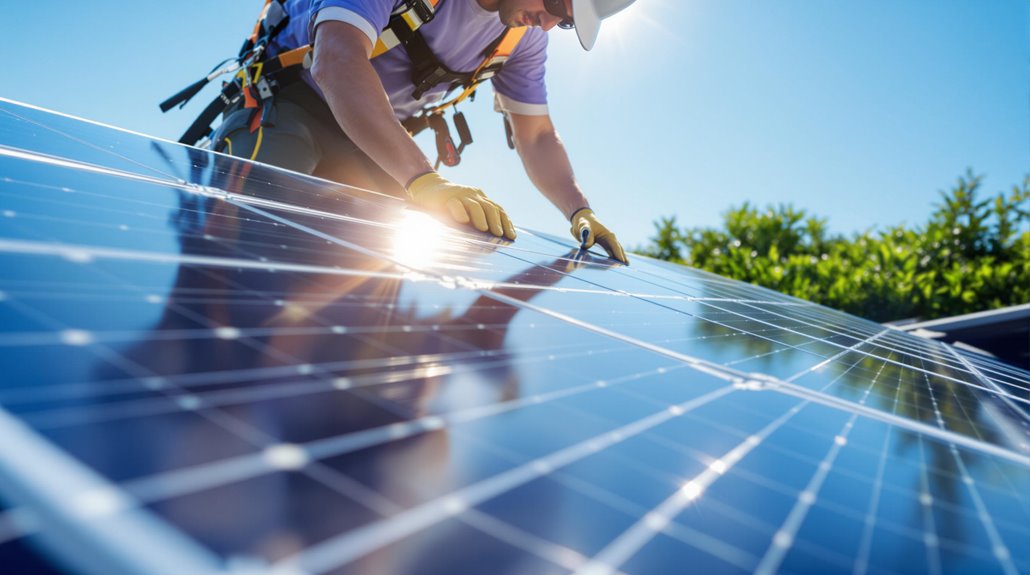
Owning rooftop solar panels requires minimal ongoing maintenance throughout their 25-35 year operational lifespan. Since these energy systems have no moving parts, maintenance primarily consists of cleaning and professional inspections to guarantee peak performance as panels face environmental elements while they power your home.
| Maintenance Task | Frequency | Cost | Notes |
|---|---|---|---|
| Professional Inspection | Annual | $150-300 | Check connections & hardware |
| Panel Cleaning | 2-4x/year | DIY/Variable | Location-dependent |
| Inverter Replacement | 10-15 years | $1,000-2,500 | Critical component |
| End-of-Life Disposal | After 25-35 years | Varies | EPA regulated |
Natural rainfall typically provides adequate cleaning in most climates, though dusty regions may require additional manual cleaning. System owners should budget for annual professional inspections to verify electrical connections, mounting hardware integrity, and overall performance metrics. The most significant maintenance expense occurs when inverters require replacement, typically after 10-15 years of operation.
Benefits Of Public Adjusters For Solar Panel Home Insurance Claims & Questions
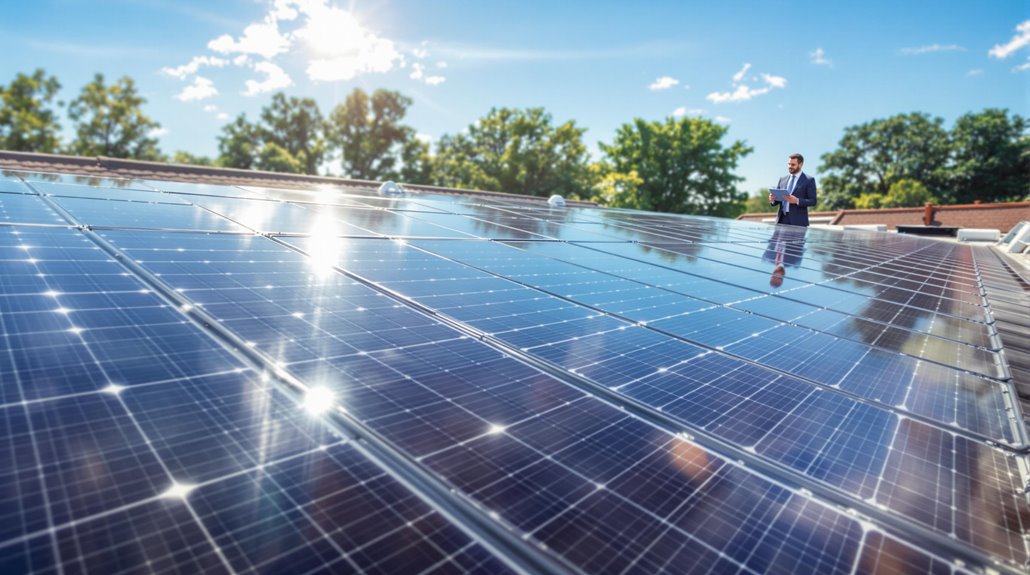
Public adjusters offer specialized expertise in solar panel insurance claims, providing objective damage assessments and facilitating higher settlement amounts through their deep understanding of policy coverage specific to renewable energy installations.
Their involvement guarantees a streamlined claims process while maintaining access to a vetted network of qualified solar installers, roofers, and contractors for accurate repair estimates and quality workmanship.
These professionals serve as valuable advocates during theft incidents or damage claims, leveraging their technical knowledge to document losses thoroughly and negotiate effectively with insurance carriers.
Expertise In Solar Insurance Policies & Claims
When solar panel systems sustain damage from severe weather or other perils, handling the complex insurance claims process requires specialized expertise that public adjusters can provide. These professionals understand the intricate details of policy coverage specific to renewable energy systems and accurately assess both direct physical damage and consequential losses.
Public adjusters typically secure 20-40% higher claims settlements by meticulously documenting solar-specific issues like hail damage, electrical surges, and inverter failures. Their expertise in current market replacement costs and proper valuation of expensive components guarantees thorough damage assessment.
Working on contingency fees of 5-15%, they offer accessible representation while maneuvering complex coverage exclusions. Their specialized knowledge of both residential property coverage and solar equipment values proves invaluable in maximizing insurance claim outcomes for homeowners.
Expert Objective Damage & Theft Assessments
To properly evaluate solar panel damage and theft claims, certified public adjusters employ specialized assessment protocols that systematically document physical damage, performance issues, and missing components. Using thermal imaging and voltage testing equipment, adjusters detect hidden impairments like microcracks and performance degradation that may escape visual inspection.
These experts maintain exhaustive documentation through detailed photography, video evidence, and serial number cataloging of affected components. Their thorough assessments typically result in 15-40% higher insurance claim settlements compared to direct negotiations with carriers.
Public adjusters' expertise in interpreting complex policy language helps identify coverage gaps and prevent common claim denials. While charging 5-15% of settlements, their specialized knowledge in valuing both physical damage and consequential losses like reduced power generation provides significant value to solar system owners.
Streamlined Claim Process
Nearly all homeowners benefit from streamlined solar panel insurance claims when working with public adjusters who professionally manage the entire process from documentation to settlement. Public adjusters substantially increase claim settlements by 40-350% compared to homeowner-filed claims through their expertise in policy coverage interpretation and accurate damage assessment.
These specialists excel at compiling extensive documentation, including engineering evaluations, performance metrics, and detailed cost analyses for both direct damage and consequential losses.
Their thorough approach encompasses all system components, from panels and inverters to mounting hardware, while accounting for decreased system efficiency and energy production. Public adjusters handle complex communications with insurance companies, ensuring proper valuation of physical damage costs and associated economic impacts, ultimately maximizing the settlement value for homeowners.
Higher Claim Payouts & Settlements
Statistical evidence demonstrates that public adjusters dramatically increase solar panel insurance claim settlements, with homeowners receiving payouts up to 747% higher compared to self-filed claims between 2018-2022.
These significant settlement increases stem from adjusters' expertise in documenting complex damage patterns and technical specifications that insurers frequently overlook.
Professional assessments of hail, wind, and electrical surge damage typically result in $15,000-$45,000 higher payouts for residential claims. Claims involving battery storage systems and inverters show particularly substantial increases, often 300-500% higher when adjusters document interconnected system damage.
Their knowledge of current solar technology costs and installation requirements prevents insurance companies from undervaluing replacement expenses, ensuring homeowners receive full compensation rather than partial repair coverage.
High Quality & None-Biased Network Of Trusted Solar, Roofing, & Home Contractors
Beyond their expertise in maximizing claim settlements, public adjusters provide policyholders access to a carefully vetted network of contractors and specialists. This network includes solar panel installers, roofers, and other professionals who have demonstrated consistent quality and reliability through their work.
Public adjusters are legally prohibited from receiving any compensation for contractor referrals, guaranteeing unbiased recommendations based solely on proven performance. This arrangement benefits policyholders, as contractors value their relationships with public adjusters and typically provide fair, competitive estimates to maintain these essential referral sources.
Having a public adjuster review contractor estimates is particularly advantageous, as their industry knowledge helps verify realistic pricing for solar panel installations and related work. Their established relationships with trusted contractors often result in more timely, dependable service for policyholders.
About The Public Claims Adjusters Network (PCAN)
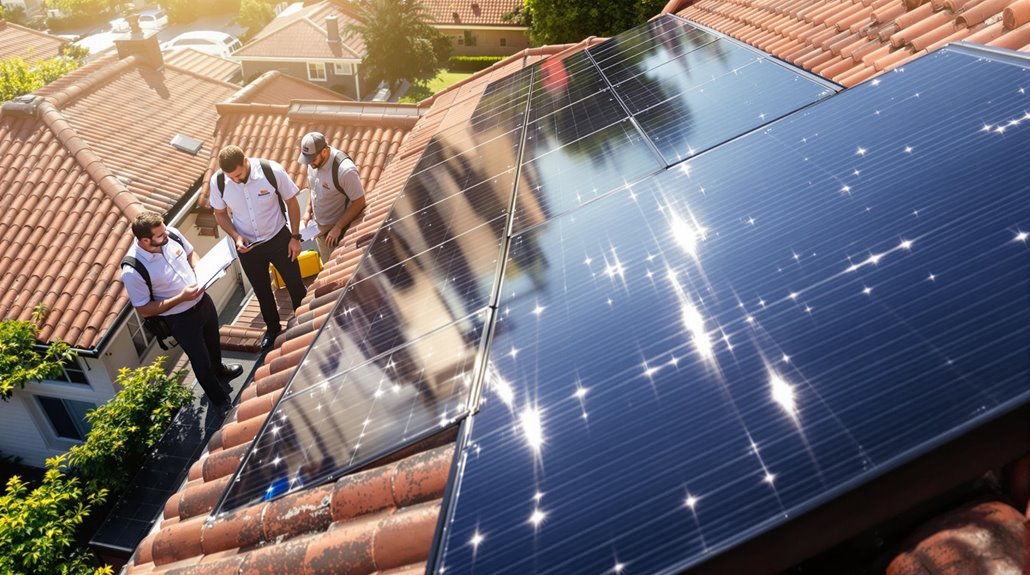
The Public Claims Adjusters Network (PCAN) operates as a nationwide consortium of state-licensed public adjusters who have undergone extensive vetting and verification processes. These specialists handle insurance claims for both residential and commercial property damage, including issues related to solar panels and roof systems across 40+ states.
| Aspect | PCAN Advantage |
|---|---|
| Coverage Types | 30+ specialized claim categories |
| Quality Control | Annual license and complaint audits |
| Geographic Reach | Present in 40+ states |
| Expertise Level | Industry-leading specialists |
| Member Standards | Rigorous vetting and ethics requirements |
PCAN serves as a critical intermediary, connecting policyholders with qualified adjusters who specialize in their specific type of claim. The network maintains strict professional standards through mandatory yearly audits and continuous monitoring of member performance. Each adjuster must demonstrate exceptional expertise in their field and undergo an intensive application process before acceptance into the network.
Frequently Asked Questions
What Is the Downside of Solar Panels on the Roof?
Heavy as an elephant's footprint, solar panels threaten structural integrity, cause roof leaks, incur high installation costs, require ongoing maintenance, create aesthetic concerns, face shading issues, and have limited warranty coverage.
Can I Run AC on a Solar Panel?
Solar panels can power AC units when properly sized for power requirements and wattage calculations. Success depends on adequate panel capacity, inverter sizing, energy storage, voltage regulation, and grid connection support.
What Are the Negatives of Solar Panels?
Solar panels present challenges including high initial costs, complex installation requirements, weather dependencies, toxic material concerns, ongoing maintenance needs, energy storage limitations, grid integration complexities, and gradual performance degradation over time.
Why Is It Difficult to Sell a House With Solar Panels?
Solar contracts and lease agreements create transfer complications during sales. Buyer hesitation stems from ownership concerns, while complex installation paperwork and market perception about property values affect transaction timelines.
